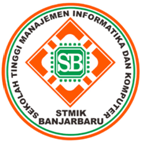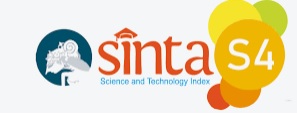Analyzing User Sentiments in Motor Vehicle Tax Applications Using the Naïve Bayes Algorithm
Abstract
The South Kalimantan Tax Info application service can provide information about the amount of tax, when you have to pay tax, the due date, and so on. However, the South Kalimantan Tax Info application received many negative reviews from users. So it is necessary to analyze user sentiment using computational techniques. In this context, sentiment analysis is applied using the Naïve Bayes method to user reviews, assisting the Regional Revenue Agency in understanding perceptions and enhancing service quality. The literature review encompasses similar studies that employ the Naïve Bayes algorithm for sentiment analysis in e-government applications. The research methodology involves collecting review data from the Google Play Store through web scraping, labeling based on ratings, and pre-processing. The results of sentiment analysis, utilizing the confusion matrix, demonstrate the highest accuracy of 92% with a 10:90 data split. This study contributes to users' comprehension of public service applications, facilitating continuous improvement.
Keywords: Sentiment analysis; Confusion matrix; Text mining; Emoticon
Â
Abstrak
Layanan aplikasi Info Pajak Kalsel dapat memberikan informasi tentang besaran pajak, waktu harus bayar pajak, jatuh tempo dan lain-lain. Namun, aplikasi Info Pajak Kalsel menerima banyak ulasan negatif dari pengguna. Maka diperlukan analisis sentimen pengguna menggunakan teknik komputasi. Dalam konteks ini, analisis sentimen diterapkan menggunakan metode Naïve Bayes pada ulasan pengguna, membantu Badan Pendapatan Daerah memahami persepsi dan meningkatkan kualitas layanan. Studi literatur mencakup penelitian sejenis yang menggunakan algoritma Naïve Bayes untuk analisis sentimen pada aplikasi e-Government. Metodologi penelitian melibatkan pengumpulan data ulasan dari Google Playstore melalui web scraping, pemberian label berdasarkan rating, dan proses pre-processing. Hasil analisis sentimen menggunakan confusion matrix menunjukkan akurasi tertinggi sebesar 92% pada pembagian data 10:90. Studi ini memberikan kontribusi pada pemahaman pengguna terhadap aplikasi pelayanan publik, memungkinkan perbaikan berkelanjutan.
Kata kunci: Analisis sentimen; Matriks konfusi; Text mining; EmotikonReferences
A. A. G. S. Utama, “The Implementation of e-Government in Indonesia,†International Journal Of Research In Business And Social Science, vol. 9, no. 7, pp. 190-196, 2020.
W. Ariannor, D. R. Safitri dan R. Rahmi, “Analisis Usability Sistem Permohonan Legalisir Menggunakan Metode System Usability Scale,†Jutisi: Jurnal Ilmiah Teknik Informatika dan Sistem Informasi, vol. 12, no. 2, pp. 415-424, 2023.
S. A. Saputra, D. Rosiyadi, W. Gata dan S. M. Husain, “Sentiment Analysis Analysis of E-Wallet Sentiments on Google Play Using the Naive Bayes Algorithm Based on Particle Swarm Optimization,†RESTI (Rekayasa Sistem dan Teknologi Informasi), vol. 3, no. 3, pp. 377-382, 2019.
D. M. K. Oshadi and S. Thelijjagoda, “AppGuider: Feature Comparison System using Neural Network with FastText and Aspect-based Sentiment Analysis on Play Store User Reviews,†in 2022 3rd International Conference on Smart Electronics and Communication (ICOSEC), pp. 1148 – 1155, Trichy, 2022.
A. KovaÄević dan Ž. KovaÄević, “Alati Za Analizu Sentimenta,†Polytechnic & Design, vol. 9, no. 3, pp. 167-174, 2021.
B. Liu, Sentiment Analysis and Opinion Mining, Toronto: Springer Nature, 2022.
B. Liu, Sentiment Analysis and Opinion Mining, Toronto: Springer Nature, 2022.
F. Kristanto, W.W. Winarno, & A. Nasiri, “Perbandingan Algoritme Naïve Bayes dan Decision Tree Pada Analisis Sentimen Data Komentar Siswa Pada Aplikasi Digital Teacher Assessment. Jutisi: Jurnal Ilmiah Teknik Informatika dan Sistem Informasi, vol. 12, no. 2, pp. 538-548, 2023.
S. Fathimah, B. Pambudhi, & D. Mulyani, “MODEL APLIKASI DIAGNOSIS PENYAKIT ANJING MENGGUNAKAN METODE NAÑ—VE BAYESâ€. In Prosiding Seminar Nasional Mahasiswa Fakultas Teknologi Informasi (SENAFTI), 2023, Vol. 2, No. 2, pp. 1154-1163.
A. I. Tanggraeni and M. N. N. Sitokdana, "Analisis Sentimen Aplikasi E-Government Pada Google Play Menggunakan Algoritma Naïve Bayes," Jurnal Teknik Informatika dan Sistem Informasi, vol. 9, no. 2, pp. 785-795, 2022.
E. B. Susanto, P. A. Christianto, M. R. Maulana and S. W. Binabar, "Analisis kinerja algoritma naïve bayes pada dataset sentimen masyarakat aplikasi NEWSAKPOLE samsat jawa tengah," Jurnal Computer Science and Information Technology (CoSciTech), vol. 3, no. 3, pp. 234-231, 2022.
R. K. Dewi, B. Tantular, J. Suprijadi and A. A. Ptavitasari, "Analisis Sentimen Ulasan Pengguna Aplikasi E-Samsat Provinsi Jawa Barat Menggunakan Metode BiGRU," in Seminar Nasional Statistika XI 2022, pp. 1-8, Surabaya, 2022.
D. L. Kaka, G. K. Pati dan K. W. Rato, “Analisis Sentimen Komentar SIAKAD Menggunakan Metode Naive Bayes Classifier,†Jurnal Kridatama Sains dan Teknologi, vol. 05, no. 2, pp. 266-277, 2023.
A. S. Bale, G. Ghorpade, N. Naveen, R. S, S. Kamalesh, R. R dan R. B. S, “Web Scraping Approaches and their Performance on Modern Websites,†dalam 2022 3rd International Conference on Electronics and Sustainable Communication Systems (ICESC), pp. 956-059, Coimbatore, 2022.
A. Alkabkabi dan M. Taileb, “Ensemble Learning Sentiment Classification for Un-labeled Arabic Text,†dalam ICC 2019: Advances in Data Science, Cyber Security and IT Applications, pp. 203-210, Cham, 2019.
S. K. Johal dan R. Mohana, “Effectiveness of Normalization Over Processing of Textual Data Using Hybrid Approach Sentiment Analysis,†International Journal of Grid and High Performance Computing (IJGHPC), vol. 12, no. 3, pp. 43-56, 2020.
N. P. Ririanti dan A. Purwinarko, “Implementation of Support Vector Machine Algorithm with Correlation-Based Feature Selection and Term Frequency Inverse Document Frequency for Sentiment Analysis Review Hotel,†Scientific Journal of Informatics, vol. 8, no. 2, pp. 297-303, 2021.
C. H. Yutika, A. Adiwijaya dan S. A. Faraby, “Analisis Sentimen Berbasis Aspek pada Review Female Daily Menggunakan TF-IDF dan Naïve Bayes,†Jurnal Media Informatika Budidarma, vol. 5, no. 2, pp. 422-430, 2021.
R. Noviana dan I. Rasal, “Penerapan Algoritma Naive Bayes dan SVM Untuk Analisis Sentimenboy Band BTS Pada Media Sosial Twitter,†Jurnal Teknik dan Science, vol. 2, no. 2, pp. 51-60, 2023.
H. Chen dan D. Fu, “An Improved Naïve Bayes Classifier for Large Scale Text,†dalam Proceedings of the 2018 2nd International Conference on Artificial Intelligence: Technologies and Applications (ICAITA 2018), pp. 21-24, Chengdu, 2018.
M. M. Fahmy, “Confusion Matrix in Binary Classification Problems: A Step-by-Step Tutorial,†Journal of Engineering Research (ERJ), vol. 6, no. 5, pp. T1-T10, 2022.
How To Cite This :
Refbacks
- There are currently no refbacks.










